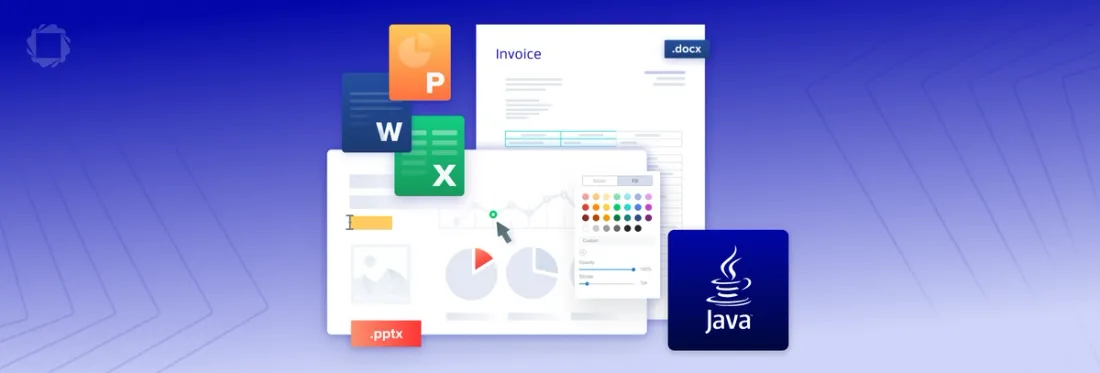Simplify Document Generation With the Fluent Java Engine
By Ian Peterson | 2023 Jul 17

4 min
Tags
java
document generation
fluent
report generation
In today's digital age, generating dynamic and personalized documents is crucial for businesses across various industries. To automate this process and empower Java developers, Apryse offers the Fluent Java Engine — a powerful document generation solution that allows you to create sophisticated documents effortlessly. In this blog post, we will explore how the Fluent Java Engine revolutionizes document generation and enhances your Java development workflow.
Introducing the Fluent Java Engine: A Developer's Dream
The Fluent Java Engine provides a robust and flexible framework for generating documents programmatically. Key features include:
- Java-based API: Utilize a developer-friendly API to seamlessly integrate document generation capabilities into your Java applications.
- Template-driven approach: Design dynamic document templates in Microsoft Office using a familiar syntax, making it easier to create and modify templates.
- Data binding: Bind data from various sources, such as databases or web services, to the document template, enabling dynamic content generation.
- Extensive formatting options: Customize the appearance of your documents with advanced formatting options, including fonts, colors, tables, and images.
- Conditional logic: Incorporate conditional statements, loops, and calculations into your templates, allowing for complex document generation scenarios.
Streamlined Document Generation Process
Generating a document using the Fluent Java Engine involves the following steps:
Step 1: Set up the template: Start by creating or modifying a document template using the Fluent Designer add-in for Microsoft Office Word, Excel, or PowerPoint.
Step 2: Bind data: Connect your data sources with the Fluent Java Engine by mapping data fields to the corresponding placeholders in the template. This enables automatic data population during document generation.
Step 3: Generate the document: Invoke the Fluent Java Engine's API to process the template and data, generating the final document output. The engine dynamically replaces placeholders with the provided data, producing personalized and accurate documents. The generated output can be seamlessly produced in a wide range of formats, such as DOCX, PDF, HTML, and numerous others.
// To generate a report, first we need a ProcessReport object. For now, we're using the
// pdf format to output.
File fileReport = new File("out/report.pdf");
FileInputStream template = new FileInputStream("data/template.docx");
FileOutputStream reportStream = new FileOutputStream(fileReport);
ProcessReport report = new ProcessPdf(template, reportStream);
// Preparation...
report.processSetup();
// Set up the datasource. The parameters are connector package, url, username, password.
// For each type of datasource, the connector package is different
DataSourceProvider datasource = new SaxonDataSource(new FileInputStream("data/data.xml"));
// Finally, send it to Windward for processing. The second parameter is the name of the
// datasource. This should match the name used in your template.
report.processData(datasource, "Orders");
// And... DONE!
report.processComplete();
template.close();
reportStream.close();
System.out.println("Launching report " + fileReport.getAbsolutePath());
SystemWrapper.LaunchFile(fileReport.getAbsolutePath()); For a more detailed look at generating documents with Fluent, check out this getting started guide on our Fluent Docs site.
Benefits of Using the Fluent Java Engine
By leveraging the Fluent Java Engine in your Java development workflow, you unlock several advantages:
- Increased productivity: With a streamlined document generation process and a developer-centric API, you can generate documents efficiently, saving valuable development time.
- Dynamic and personalized content: Seamlessly merge data from multiple sources into your document templates, allowing for personalized and relevant content generation.
- Consistency and brand compliance: Ensure brand consistency across all generated documents by using standardized templates, guaranteeing a professional and polished appearance.
- Agile document updates: Modify document templates on-the-fly, without redeploying your application, ensuring flexibility and agility in response to changing business requirements.
- Integration capabilities: Easily integrate the Fluent Java Engine with existing Java applications, frameworks, and libraries, maximizing compatibility and minimizing development effort.
The Fluent Java Engine empowers Java developers to simplify the document generation process, saving time and effort while maintaining the flexibility to create dynamic and personalized documents. With its intuitive API, template-driven approach, and seamless data integration capabilities, the Fluent Java Engine revolutionizes document generation in Java applications.
Discover the art of document generation with the Fluent .NET Engine in this blog.
To experience the power of the Fluent Java Engine firsthand, integrate it into your Java projects, and witness how it streamlines your document generation workflow. Unlock the potential of dynamic and personalized document generation with the Fluent Java Engine from Apryse.
Learn more about document assembly. Read our blog.
Conclusion
Contact us today to learn more about how our solutions can enhance your document generation process and maximize your productivity, or sign up for a free trial.
Tags
java
document generation
fluent
report generation

Ian Peterson
Software Engineer
Share this post



